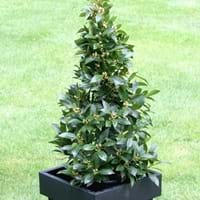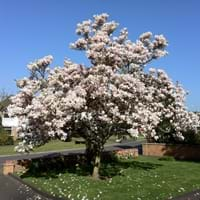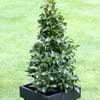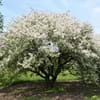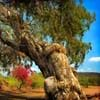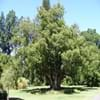Life Span
Perennial
Perennial
Origin
Northeastern United States, Mid-Atlantic United States, Southeastern United States, South-Central United States
Hybrid origin
Types
Cherry laurel, California Bay Laurel, Spotted laurel
Gwillimia, Manglietia, Kmeria
Habitat
Tropical regions
Subtropical climates, Tropical regions
USDA Hardiness Zone
5-9
6-9
Sunset Zone
4, 5, 6, 7, 8, 9, 14, 15, 16, 17, 18, 19, 20, 21, 22, 23, 24
Not Available
Habit
Oval or Rounded
Oval or Rounded
Flower Color
White, Ivory
Purple, Pink, Light Pink, Rose
Flower Color Modifier
Bicolor
Bicolor
Fruit Color
Orange Red
Brown
Leaf Color in Spring
Green, Light Green, Blue Green, Silver
Green
Leaf Color in Summer
Green, Light Green, Blue Green, Silver
Green
Leaf Color in Fall
Green, Yellow green, Tan, Silver
Green, Yellow green, Sandy Brown
Leaf Color in Winter
Green, Yellow green, Tan
Not Available
Plant Season
Spring, Summer, Fall, Winter
Spring, Summer
Sunlight
Full Sun, Partial Sun
Full Sun, Partial Sun
Growth Rate
Medium
Medium
Type of Soil
Clay, Loam, Sand
Clay, Loam, Sand
The pH of Soil
Acidic, Neutral
Acidic, Neutral
Soil Drainage
Average
Well drained
Bloom Time
Late Spring, Early Summer, Summer
Spring, Late Spring
Tolerances
Wet Site
Not Available
Where to Plant?
Ground
Ground
How to Plant?
Grafting, Stem Planting
Seedlings, Transplanting
Plant Maintenance
Medium
Medium
Watering Requirements
Do Not over Water, occasional watering once established
Prefer drip-irrigation instead of Over-head watering
In Summer
Lots of watering
Lots of watering
In Spring
Moderate
Moderate
In Winter
Average Water
Average Water
Soil pH
Acidic, Neutral
Acidic, Neutral
Soil Type
Clay, Loam, Sand
Clay, Loam, Sand
Soil Drainage Capacity
Average
Well drained
Sun Exposure
Full Sun, Partial Sun
Full Sun, Partial Sun
Pruning
Prune for shortening long shoots, Remove damaged leaves, Remove dead branches, Remove dead leaves
Prune if you want to improve plant shape
Fertilizers
fertilize in growing season
Fertilize in late fall, fertilize in spring, Requires high amount of nitrogen
Pests and Diseases
Beetles, Fusarium wilt, Rust, Scab
Aphids, Bacterial Blight, Canker, Crown gall, Hoplia beetle, Leaf burn, Leaf spot, Mealybugs, Powdery mildew, Red blotch, Scorch, Soft scales, Thripes, Wetwood
Plant Tolerance
Drought, Salt and Soil Compaction, Shade areas
Not Available
Flower Petal Number
Single
Single
Foliage Texture
Coarse
Coarse
Foliage Sheen
Glossy
Matte
Attracts
Birds, Butterflies
Not Available
Allergy
allergic conjunctivitis, Nausea, wheezing
Not Available
Aesthetic Uses
Cottage Garden, Showy Purposes
Showy Purposes
Beauty Benefits
For treating wrinkles, Hair Conditioner, Making cosmetics
Treatment of Dark Spots
Edible Uses
Sometimes
Yes
Environmental Uses
Air purification, Indoor Air Purification, Insect Repellent
Air purification
Medicinal Uses
Acne, Cancer, Diarrhea, Emollient, Migraines, Oral health, treating poison ivy
Alzheimer’s Disease, Anxiety, Cancer, Digestion problems, Liver problems, Menstrual Cramps, Respiratory Disorders, Weight loss
Part of Plant Used
Flowers, Leaf Stalks, Stem
Whole plant
Other Uses
Cosmetics, Culinary use, Florist trade and landscaping, Making Perfumes, Oil is used in perfume, soaps, creams, etc., Used as Ornamental plant
Used as Ornamental plant, Used for its medicinal properties
Used As Indoor Plant
Yes
Yes
Used As Outdoor Plant
Yes
Yes
Garden Design
Feature Plant, Foundation, Shade Trees
Feature Plant, Foundation, Shade Trees
Botanical Name
Laurus nobilis
MAGNOLIA 'Alexandria'
Common Name
Sweetbay
Alexandria Magnolia, Magnolia
In Hindi
Laurus nobilis
हिम चम्पा
In German
Echter Lorbeer
Magnolienbaum
In French
Laurus nobilis
magnolia
In Spanish
Laurus nobilis
árbol de magnolia
In Greek
Laurus nobilis
Magnolia δέντρο
In Portuguese
Loureiro
magnólia
In Polish
Wawrzyn szlachetny
magnolia drzewa
In Latin
Laurus nobilis
Magnolia lignum
Phylum
Magnoliophyta
Magnoliophyta
Class
Magnoliopsida
Magnoliopsida
Order
Laurales
Magnoliales
Family
Magnoliaceae
Magnoliaceae
Clade
Angiosperms, Monocots
Angiosperms, Magnoliids
Tribe
Epidendreae
Not Available
Subfamily
Epidendroideae
Not Available
Importance of Sweetbay and Magnolia Tree
Want to have the most appropriate plant for your garden? You might want to know the importance of Sweetbay and Magnolia Tree. Basically, these two plants vary in many aspects. Compare Sweetbay and Magnolia Tree as they differ in many characteristics such as their life, care, benefits, facts, etc. Every gardener must at least have the slightest clue about the plants he wants to plant in his garden. Compare their benefits, which differ in many ways like facts and uses. The medicinal use of Sweetbay is Acne, Cancer, Diarrhea, Emollient, Migraines, Oral health and treating poison ivy whereas of Magnolia Tree is Alzheimer’s Disease, Anxiety, Cancer, Digestion problems, Liver problems, Menstrual Cramps, Respiratory Disorders and Weight loss. Sweetbay has beauty benefits as follows: For treating wrinkles, Hair Conditioner and Making cosmetics while Magnolia Tree has beauty benefits as follows: For treating wrinkles, Hair Conditioner and Making cosmetics.
Compare Facts of Sweetbay vs Magnolia Tree
How to choose the best garden plant for your garden depending upon its facts? Here garden plant comparison will help you to solve this query. Compare the facts of Sweetbay vs Magnolia Tree and know which one to choose. As garden plants have benefits and other uses, allergy is also a major drawback of plants for some people. Allergic reactions of Sweetbay are allergic conjunctivitis, Nausea and wheezing whereas of Magnolia Tree have Not Available respectively. Having a fruit bearing plant in your garden can be a plus point of your garden. Sweetbay has no showy fruits and Magnolia Tree has no showy fruits. Also Sweetbay is not flowering and Magnolia Tree is not flowering . You can compare Sweetbay and Magnolia Tree facts and facts of other plants too.
